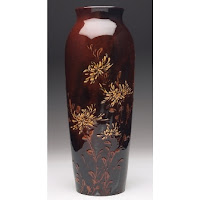Rookwood Glazes
 |
| Rookwood Vase by Kataro Shirayamadani |
If you read my last blog you are now an expert in the
history of the Rookwood Pottery company. OK so you know enough to hold your own on
the subject at a cocktail party. If you want to be able to recognize a fair Rockwood
price at an antique store you need to know about the glazes. If you want to buy
a major bargain at an estate sale you need to know about the first and most
important glazes.
OK were you paying attention in my last blog I told you that
the first pieces made from Rookwood had no name, but were commonly referred to
as what?
A) Cincinnati
Wedgwood
B) Cincinnati
Limoges
C) Cincinnati
Meissen
 |
| Standard Glaze |
Standard Glaze
The most desirable Rookwood Pottery |
| Standard-Green-M.A. Daly 1900 |
 |
| Add caption |
glaze is simply named Standard. Not the most inventive name, for their most popular glaze and the style most copied over the years. The Standard glaze line is dark; the base color is mostly in brown, sometimes green. The background color usually starts dark and then gradually lightens with a yellow shiny over glaze. Each Standard piece when held in the light should look like its’ outside during sunset. The background color should look like its’ dissolving. Kind of like when you pour a bottle of Black & Tan into a glass. Each Standard piece should also have excellent high quality decorations; the key to Rookwood Pottery’s auction value is the artist and the quality of the painting. The better the painted image the most important and valuable the piece. Some of the most valuable Standard glaze pieces are portraits of Native American’s. Most notably the pillow pot pictured upper right painted by Matthew A. Daly in 1900 and in 2004 sold for $65,000 at auction.
Lydia’s Opinion
While I appreciate the Standard glaze line and understand
why the pieces are important I don’t just don’t like them. The color combination
just reminds me of my most hated vintage item ever Brown Drip Ware. I am not picking
on any particular brand Hull, Haeger, Marcrest, McCoy, Pfaltzgraff, I can’t stand all your brown drip
styles equally. I don’t know why but seeing sad brown pottery, ceramics, and
stoneware with ring around the collar just makes me sad. I can’t even stand seeing
brown drip bean pots and I am from Boston.
I know in my mind that aesthetically there is a big
difference between handmade expertly decorated and glazed Rookwood Standard and
mass produced Hull pottery. However my eyes like what they like.
Mahogany
 |
| Mahogany by Laura Fry 1885 |
 |
| 1897 M.A. Daly |
Tiger Eye and Goldstone
 |
| Tiger Eye- Albert Robert, Valentien 1900 |
 |
| Close up of vase on lower left Gold Stone's flecks |
 |
| Gold Stone Albert Valentien 1884 |
Gold Stone
The Goldstone line used their other experimental glaze, “Aventurine”. Aventurine glaze is also a science experiment of sorts with a complex heating and cooling procedure. The end result is a fine sparkling metallic see close up of glaze on above right. See the effect like tiny pieces of glitter put into the glaze? Below right I found a Gold Stone vase with an auction estimate of $2000-$3000. However the vase was described as Tiger Eye. I found that with these early glazes their is a lot of confusion. I found all of the early glazes; Standard, Mahogany, Tiger Eye and Gold Stone all labeled incorrectly. Remember that just because an item is in a fancy antique store or brand name auction people make mistakes. You are not going to be one of those people.
Limoges: 1880-1884 Clear glaze over under (slip) painting. Check date on bottom.
Standard: 1884-1909 Yellowish glaze over brown or green ( black and tan dissolving) background.
Mahogany: 1884-1900 natural red clay background yellowish tinted glaze.
Tiger Eye: 1884-1909 Crystalline glaze, like gold foil under glass.
Gold Stone: 1884-1900 Aventurine Glaze, like tiny specks of glitter (see sample).
Check the bottom! Always check the date. None of these glazes were used after 1900 or 1909. If you see a Rookwood Tiger Eye vase dated 1945 in a fancy antique store you know it's labeled wrong. You are now an early Rookwood Pottery super star!
I don’t have time to go into all of the different glazes invented by those brave folks at Rookwood pottery. My favorites Rookwood glazes are Iris, Sea Green, Poppies, and Vellum check them out if you have time. But this isn’t about me it’s about the scientific geniuses, gifted potters, and superb artists of Rookwood pottery. Their innovation and skill made them one of the most celebrated Art Pottery companies of the twentieth century.
If you want to make a good buy check the piece out. Never buy a cracked or chipped piece. You are looking for even glaze, pretty form, most importantly you want beautiful decorations, perhaps even an important artist. All of the pieces are singed by the artists. Most Rookwood pottery books will have a list of artists and glazes with dates. If you are going to spend a lot of money on a piece make sure you research as you know the description may be wrong. Most important of all buy a piece that you think is beautiful.


No comments:
Post a Comment